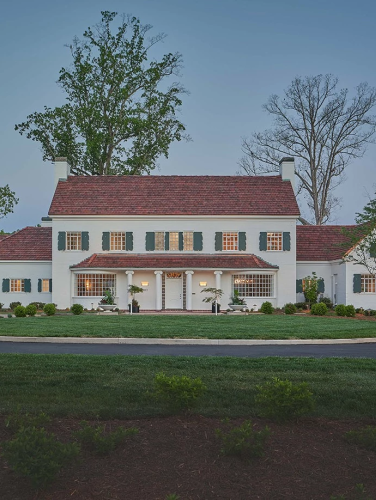
Charles E. Barnhardt House
(ca. 1938)
Important example of the pre-WWII work of prominent Charlotte architect Martin E. Boyer, Jr., uniquely blending Colonial Revival and Art Moderne styles.
3217 Maymont Pl, Charlotte, NC 28205
Prominent Charlotte architect Martin E. Boyer, Jr. skillfully combined elements of Colonial Revival and Art Modene architectural styles in his design of the Charles E. Barnhardt House, which is situated on several tracts of land originally part of the Club Acres subdivision. Originally built for Charles Barnhardt (1882-1938) and his wife Edna, the couple never resided in the house. During a May 1938 visit to the still-active construction site, Charles left Edna at the house while he inspected a pond and concrete dam on the estate. Workmen later found Charles’ dead body in the lake. Speculation at the time suggested he may have tripped on fish netting strung along the top of the dam and fallen in the water. Following her husband’s untimely death, Edna remained at Fourth Ward’s Poplar Apartments, the couple’s temporary residence during construction, never to move into the house that bears their name.
Property Quick Links
A native of Cabarrus County, Charles Barnhardt was something of an entrepreneur, leveraging his early success as a cotton buyer for Cannon Mills and a Charlotte cotton broker to partner with his younger brother William in 1927 to purchase and convert the old Linden Cotton Mill in Davidson into Kubar Manufacturing, an industrial plant that produced asbestos shingles. In 1934 he again teamed up with William to form Barnhardt Brothers, a cotton yarn brokerage company. Charles also served as president of Plaza Railway Inc., the small trolley line that served Club Acres and the other Plaza-Midwood neighborhoods. Charles was active in the Charlotte community as a member of both Second Presbyterian Church and the Charlotte Country Club, a trustee of the Presbyterian Hospital, a Shriner, and a Mason.
Following Charles’ tragic death, the house was sold to Walter R. Hollingsworth whose local business ventures included Comptometer Company (adding machines) and Charlotte Music Company (jukeboxes and phonographs). George B. and Elizabeth Crooks Cramer purchased the property in 1948, where they lived until George’s death in 1995 and Elizabeth’s death in 2006. Born in 1903, George was the youngest son of noted Charlotte industrialist Stuart W. Cramer. Following his service in World War II, George partnered with his half-brother Stuart W. Cramer, Jr. to form the Charlotte textile firm Cramer and Cramer.
Raised in Charlotte, Martin E. Boyer, Jr. (1893-1970) became a favored architect among the city’s elite, designing homes in the Colonial, Tudor and Georgian styles, including the 1922 J. Luther Snyder House in Myers Park and the 1929 Hamilton Jones House in Eastover. Boyer is considered by many to be Charlotte’s most important revivalist architect. Other notable Boyer commissions include the Stuart W. Cramer, Jr., House on Hermitage, several S&W Cafeterias throughout North Carolina, Piedmont Courts (Charlotte’s first public housing project, no longer standing), and Davidson College’s Jackson Court. Boyer was also instrumental in saving Charlotte’s 1837 U.S. Mint building. He intervened when the West Trade Street building was slated for demolition, rescuing the materials and rebuilding it as the Mint Museum of Art on Randolph Road.

